|
|
|
|
|
Oil On
Canvas, Real Flavor of Old Masters
|
|

|
ARTWORKS
INDEX
A B C D E F G H I J K L M N O P Q R S T U V W X Y Z |
ARTISTS
INDEX
A B C D E F G H I J K L M N O P Q R S T U V W X Y Z |
|
|
| | |
|
|
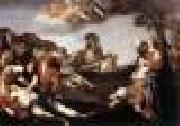 |
CAMASSEI, Andrea -- Click Here
|
|
Italian painter, Roman school (b. 1602, Bevagna, d. 1649, Roma)
Andrea Camassei (1602-1649) was an Italian painter of the Baroque, who was mainly active in Rome under the patronage of the Barberini. He was born in Bevagna. He was active in painting in the Palazzo Barberini as well as in Antonio Barberini's favored church, Santa Maria della Concezione, where he painted the Assumption of the Virgin on the dome. His training was under Domenichino, but he also labored under the direction of Sacchi and Pietro da Cortona. He painted a Triumph of Constantine for the Baptistery of the Lateran Palace. He painted for the Taddeo Barberini, two large canvases (1638-39) depicting Massacre of the Niobids and Hunt of Diana. He also painted a Saints Bonaventura, Bernardino & Ludovico da Tolosa for Santa Caterina in Rapecchiano (Spello). |
|
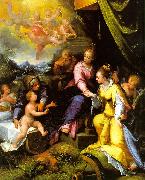 |
Calvaert, Denys -- Click Here
|
|
Flemish, 1540-1619
Flemish painter and draughtsman, active in Italy. In 1556-7 he was inscribed in the registers of the painters' corporation in Antwerp as a pupil of the landscape painter Kerstiaen van Queboorn (1515-78). Calvaert went to Bologna c. 1560, where he was to remain for the rest of his life. There he came under the protection of the influential Bolognini family and entered the workshop of Prospero Fontana the elder. After about two years he left Fontana to work with Lorenzo Sabatini, with whom he collaborated on several pictures, including the Holy Family with the Archangel St Michael (Bologna, S Giacomo Maggiore) and an Assumption (Bologna, Pin. N.). Calvaert's oeuvre is composed almost exclusively of religious works, ranging in size from vast altarpieces to small devotional pictures on copper. This sets him apart from other Netherlandish painters, notably those of the school of Prague, for whom Classical mythology was a constant source of inspiration. His first signed and dated work was Vigilance (1568; Bologna, Pin. N.); thereafter he developed a more original style, as in the Noli me tangere (Bologna, Pin. N.). |
|
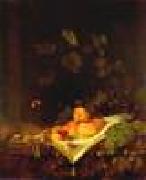 |
CALRAET, Abraham van -- Click Here
|
|
Dutch painter, Dordrecht school (b. 1642, Dordrecht, d. 1722, Dordrecht)
Dutch painter. He was the eldest son of Pieter Jansz. van Calraet (c. 1620-81), a sculptor from Utrecht. According to Houbraken, Abraham was taught by the Dordrecht sculptors Aemilius and Samuel Huppe, although nothing is known of his activity as a sculptor. Houbraken also stated that Abraham learnt to paint figures and fruit and that his brother Barent van Calraet (1649-1737), who specialized at first in horse paintings but later imitated the Rhine landscapes of Herman Saftleven, was a pupil of Aelbert Cuyp (see CUYP, (3)). The known signed works by Barent confirm this. A painting of two horses in a stable, initialled APK (Rotterdam, Mus. Boymans-van Beuningen), indicates that Abraham, too, must have been well acquainted with Cuyp and provides the basis for identifying Abraham's painting style. A large number of landscapes with horses, paintings of livestock in stables and still-lifes, all initialled A.C. and formerly attributed to Aelbert Cuyp, |
|
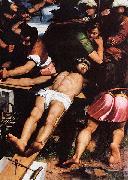 |
Callisto Piazza -- Click Here
|
|
(1500-1561) was an Italian painter.
Callisto, a member of the Piazza family of painters, was born in Lodi, Lombardy.
In 1523 he was working in Brescia. His first dated and signed work is from the following year, and shows a typical Brescian style. This style was then emerging, and included artists such as Romanino and Moretto. Piazza shows influences from contemporaries such as Dosso Dossi and Ludovico Mazzolino of the Ferrarese school, as well as Giovanni Agostino da Lodi.
In 1526-1529 Piazza worked in Val Camonica, at Erbanno, Borno, Breno, Esine and Cividate Camuno. In 1529 he returned to his native Lodi where he formed a workshop with his brothers Cesare and Scipione (died 1552). In 1538, while in Crema, he married the noblewoman Francesca Confalonieri. Later Callisto moved to Milan, where he received numerous commissions, such as the decoration of the San Girolamo chapel in Santa Maria Presso San Celso (1542); the decoration of the refectory of the convent of Sant'Ambrogio (1545); the frescoes for the Saletta Negra in the Castello Sforzesco; and the decoration of the Simonetta chapel in San Maurizio al Monastero Maggiore (1555), largely executed with the assistance of his son Fulvio. He also worked in Lodi at the Incoronata (1454), Novara, at the Abbey of Chiaravalle and other areas of Lombardy.
|
|
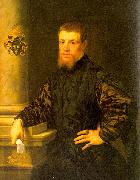 |
Calcar, Johan Stephen von -- Click Here
|
|
or Calcker, German- practiced mainly in Italy, 1499-1546 |
|
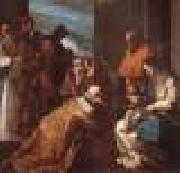 |
CAJES, Eugenio -- Click Here
|
|
Spanish painter (b. 1575, Madrid, d. 1634, Madrid) |
|
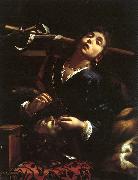 |
Cairo, Francesco del -- Click Here
|
|
Italian Baroque Era, 1598-1674 |
|
|
|
Caillebotte, Gustave -- Click Here
|
|
French Impressionist Painter, 1848-1894
.French painter and collector. Caillebotte's parents, of Norman descent, were wealthy members of the Parisian upper middle class, and his paintings often evoke his family background. After studying classics at the Lyc?e Louis Le Grand, he obtained a law degree in 1870, and during the Franco-Prussian War he was drafted into the Seine Garde Mobile (1870-71). He joined L?on Bonnat's studio in 1872 and passed the entrance examination for the Ecole des Beaux-Arts on 18 March 1873. The records of the Ecole make no mention of his work there, and his attendance seems to have been short-lived. He was very soon attracted by the innovative experiments, against academic teaching, of the young rebels who were to become known as the Impressionists. In 1874 Edgar Degas, whom Caillebotte had met at the house of their mutual friend Giuseppe de Nittis, asked him to take part in the First Impressionist Exhibition at the Nadar Gallery in the Boulevard des Capucines in Paris. However, it was only at the time of their second exhibition in April 1876 that, at Auguste Renoir's invitation, Caillebotte joined the Impressionist group. From then on he was one of the most regular participants in their exhibitions (1877, 1879, 1880, 1882). He organized the show of 1877 and made great efforts to restore the cohesion of the group by persuading Claude Monet to exhibit in 1879. |
|
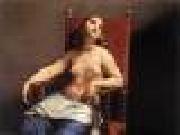 |
CAGNACCI, Guido -- Click Here
|
|
Italian Baroque Era Painter, 1601-1681 |
|
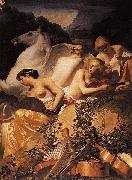 |
Caesar van Everdingen -- Click Here
|
|
(1616/17, Alkmaar - buried October 13, 1678, Alkmaar), older brother of Allart van Everdingen and Jan van Everdingen, was a Dutch Golden Age portrait painter.
Caesar Pietersz van Everdingen also known as Caesar Boetius van Everdingen was educated in Utrecht, where he learned to paint from Jan Gerritsz van Bronckhorst.Caesar became a member of the painter's guild in Alkmaar in 1632. His first known painting dates from 1636. In 1648 he moved to Haarlem, where he joined the Haarlem Guild of St. Luke and the civic guard (or schutterij) there, where he met Jacob van Campen. From 1648 to 1650 He helped him with the decoration of the Oranje Zaal (Orange room) in Huis ten Bosch. In 1658 he moved back to Alkmaar where he started a workshop and took on pupils.
Many of his pictures are to be seen in the museums and private houses of the Netherlands. His pupils were Jan Theunisz Blanckerhoff, Adriaen Dekker, Hendrik Graauw, and Thomas Heeremans.Houbraken also lists two other pupils; Adriaen Warmenhuizen, and Laurens Oosthoorn.
|
|
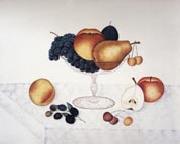 |
Cady Emma Jane -- Click Here
|
|
American artist ,
b.1854 d.1933
|
|
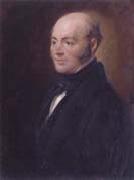 |
C.R. Leslie -- Click Here
|
|
English genre painter , 1794-1859
was an American artist best known for his cartoons and caricatures of actors and other celebrities. Though his work was heavily in demand through the 1920s and is often considered to epitomize the era, his personal life was troubled by mental illness, and he was nearly forgotten soon after his suicide, shortly before his fortieth birthday. English genre painter, was born in London on 19 October 1794. His parents were American, and when he was five years of age he returned with them to their native country. They settled in Philadelphia, where their son was educated and afterwards apprenticed to a bookseller. He was, however, mainly interested in painting and the drama, and when George Frederick Cooke visited the city he executed a portrait of the actor from recollection of him on the stage, which was considered a work of such promise that a fund was raised to enable the young artist to study in Europe. He left for London in 1811, bearing introductions which procured for him the friendship of West, Beechey, Allston, Coleridge and Washington Irving, and was admitted as a student of the Royal Academy, where he carried off two silver medals. At first, influenced by West and Fuseli, he essayed high art, and his earliest important subject depicted Saul and the Witch of Endor; but he soon discovered his true aptitude and became a painter of cabinet-pictures, dealing, not like those of David Wilkie, with the contemporary life that surrounded him, but with scenes from the great masters of fiction, from Shakespeare and Cervantes, Addison and Moliere, Swift, Sterne, Fielding and Smollett. Of individual paintings we may specify Sir Roger de Coverley going to Church (1819); May-day in the Time of Queen Elizabeth (1821); Sancho Panza and the Duchess (1824); Uncle Toby and the Widow Wadman (1831); La Malade Imaginaire, act iii. sc. 6 (1843); and the Dukes Chaplain Enraged leaving the Table, from Don Quixote (1849). |
|
|
|
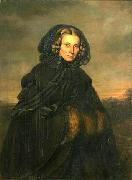 |
C. Grunewald -- Click Here
|
|
paint Portrait of Bertha Wehnert-Beckmann German photographer in 1858 |
|
|
|
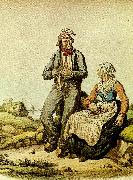 |
c. a. dahlstrom -- Click Here
|
|
Carl Petter Dahlström, född ca 1705, död 4 mars 1794, var en svensk möbelsnickare. Dahlström gesällvandrade 1745?C1755 i Nordeuropa och Frankrike, där han i Paris kom i lära hos den tidens främste ebenist Jean-François Oeben. Hos denne lärde sig Dahlström faneringstekniken marqueterie ?? fleurs eller blomsterintarsia, som var en metod för att möta rokokons krav på fanering av dubbelvälvda kroppar. Mycket tack vare rekommendationer av C.J. Cronstedt blev Dahlström efter hemkomsten till Sverige utnämnd till kunglig ebenist den 19 november 1756. Han finns representerad på Nationalmuseum med en byrå som han tillverkade tillsammans med Lorentz Nordin. Dahlström överlämnade 1769 sina privilegier till Niclas Palmgren och ägnade sig därefter åt restaurangverksamhet. |
|
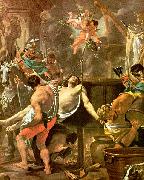 |
Brun, Charles Le -- Click Here
|
|
French Baroque Era Painter, 1619-1690
French painter and designer. He dominated 17th-century French painting as no other artist; it was not until over a century later, during the predominance of Jacques-Louis David, that artistic authority was again so concentrated in one man. Under the protection of a succession of important political figures, including Chancellor Pierre S?guier, Cardinal Richelieu and Nicolas Fouquet, Le Brun created a series of masterpieces of history and religious painting. For Louis XIV and his chief minister Jean-Baptiste Colbert he executed his greatest work, the royal palace of Versailles: an almost perfect ensemble of architecture, decoration and landscape. After Colbert's death in 1683, he was no longer able to count on prestigious commissions |
|
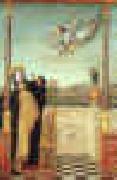 |
Braccesco, Carlo di -- Click Here
|
|
Italian, active 1478-1501 |
|
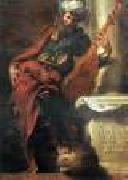 |
BOCCACCINO, Camillo -- Click Here
|
|
Italian painter, Cremonese school (b. 1504/5, Cremona, d. 1546, Cremona)
Camillo Boccaccino (c. 1504 - 1546) was an Italian painter of the Renaissance period, active mainly in Cremona and regions of Lombardy. He was the son and pupil of the painter Boccaccio Boccaccino. He was known to Gian Paolo Lomazzo and Giorgio Vasari. He painted the four evangelists (1537) in the niches of the cupola of San Sigismondo at Cremona. |
|
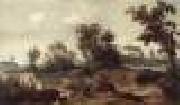 |
BLEKER, Gerrit Claesz -- Click Here
|
|
Dutch painter (active 1625-1656 in Haarlem) |
|
 |
Bingham, George Caleb -- Click Here
|
|
American Realist Painter, 1811-1879. American painter. Raised in rural Franklin County, MO, Bingham experienced from an early age the scenes on the major western rivers, the Missouri and the Mississippi, that inspired his development as a major genre painter. During his apprenticeship to a cabinetmaker, he met the itinerant portrait painter Chester Harding, who turned Bingham's attention to art. Teaching himself to draw and compose from art instruction books and engravings, the only resources available in the frontier territories, Bingham began painting portraits as early as 1834. |
|
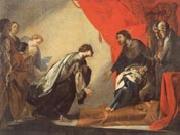 |
Bernardo Cavallino -- Click Here
|
|
Italian Baroque Era Painter, ca.1616-1656
was an Italian painter of the Baroque period, working in Naples. Born in Naples, he likely died during the plague epidemic in 1656. While his paintings are some of the more stunningly expressive works emerging from the Neapolitan artists of his day, little is known about the painter's background or training. Of eighty attributed paintings, less than ten are signed. He worked through private dealers and collectors whose records are no longer available. It is said that he trained with Massimo Stanzione, befriended the painter Andrea Vaccaro, and was influenced by Anthony Van Dyck, but his paintings could also be described as equidistant from Caravaggio and Bartolome Esteban Murillo in styles; tenebrism enveloped with a theatrical sweetness, a posed ecstasy and feeling characteristic of the high Roman baroque statuary. He is known to have worked in Neapolitan circles strongly influenced by Stanzione, which included Artemisia Gentileschi, Francesco Francanzano, Agostino Beltrano and Francesco Guarino. One of his masterpieces is the billowing maiden Virgin at the Brera Gallery in Milan. Passive amid the swirling, |
|
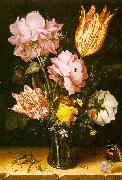 |
Berghe, Christoffel van den -- Click Here
|
|
Dutch, approx. 1590-1645 |
|
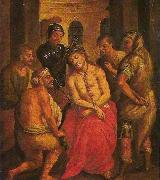 |
Bento Jose Rufino Capinam -- Click Here
|
|
painted Christ Wearing the Crown of Thorns in 1791-1874 |
|
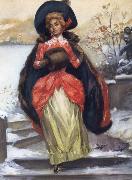 |
Benjamin West Clinedinst -- Click Here
|
|
Illustrator and Painter.
American , 1859-1931
was an American illustrator and painter, born at Woodstock, Va. He studied for a year in Baltimore and for five years in Paris under Cabanel and Bonnat and first attracted attention in New York with his illustrations for Leslie's Weekly. He was best known as the illustrator of Thomas Nelson Page's Unc' Edinburg, the works of Hawthorne, Stevenson, and Mark Twain, although he worked also in oils and water colors. His sympathetic collaboration with the author gave his work an especial charm. He was awarded the Evans prize of the American Water-Color Society in 1900. In 1947. |
|
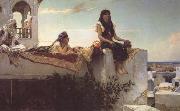 |
Benjamin Constant -- Click Here
|
|
1767-1830
French-Swiss novelist and political writer. He had a tumultuous 12-year relationship with Germaine de Staël, whose views influenced him to support the French Revolution and subsequently to oppose Napoleon, for which he was exiled (1803 C 14). He later served in the Chamber of Deputies (1819 C 30). Adolphe (1816) was a forerunner of the modern psychological novel. |
|
 |
Benjamin Champney -- Click Here
|
|
(November 20, 1817 - December 11, 1907) was a painter whose name has become synonymous with White Mountain art of the 19th century. He began his training as a lithographer under celebrated marine artist Fitz Henry Lane at Pendleton's Lithography shop in Boston. Most art historians consider him the founder of the "North Conway Colony" of painters who came to North Conway, New Hampshire and the surrounding area during the second half of the 19th century. His paintings were often used to make chromolithographs that were subsequently sold to tourists who could not afford Champney's originals. He exhibited regularly at the Boston Athenæum and was a founder of the Boston Art Club
|
|
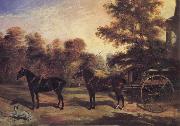 |
Benjamin Cam Norton -- Click Here
|
|
British, 1835-1900 |
|
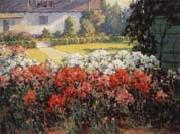 |
Benjamin C.Brown -- Click Here
|
|
American,is best remembered for his Impressionist renderings of the Sierra Mountains and poppy-filled spring meadows.1865-1942 |
|
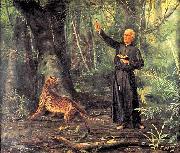 |
Benedito Calixto -- Click Here
|
|
(14 October 1853 -- 31 May 1927) was a Brazilian painter. His works usually depicted figures from Brazil and Brazilian culture, including a famous portrait of the bandeirante Domingos Jorge Velho in 1923, and scenes from the coastline of São Paulo. Unlike many artists of the time, Calixto's patron was an individual other than the state, who were "the most dependable source of patronage." |
|
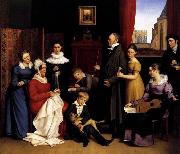 |
BEGAS, Carl the Elder -- Click Here
|
|
German painter
b. 1794, Hainsberg bei Aachen, d. 1854, Berlin |
|
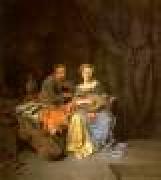 |
BEGA, Cornelis -- Click Here
|
|
Dutch Baroque Era Painter, ca.1620-1664
Dutch painter, draughtsman and etcher. He was born into prosperous circumstances; his mother, Maria Cornelis, inherited half the estate (gold, silver, paintings, drawings and prints) and all of the red chalk drawings of her father, Cornelis Cornelisz. van Haarlem, a renowned Mannerist artist. Bega's father was Pieter Jansz. Begijn (d 1648), a gold- and silversmith. Like other family members, Bega was probably Catholic. Houbraken's claim that Bega studied with Adriaen van Ostade is likely to be correct; this was probably before 24 April 1653, when Bega joined Vincent Laurentsz. van der Vinne in Frankfurt for a journey through Germany, Switzerland and France. Bega had returned to Haarlem by 1 September 1654, at which time he joined the Guild of St Luke. |
|
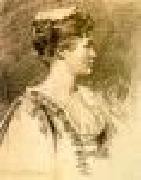 |
Beckwith James Carroll -- Click Here
|
|
American, 1852-1917
was an American portrait painter. He was born at Hannibal, Missouri, on 23 September 1852. He studied in the National Academy of Design, New York City, of which he afterwards became a member, and in Paris (1873-1878) under Carolus Duran. Returning to the United States in 1878, he gradually became a prominent figure in American art. He took an active part in the formation of The Fine Arts Society, and was president of the National Free Art League, which attempted to secure the repeal of the American duty on works of art. Among his portraits are those of William Merritt Chase (1882), Miss Jordan (1883), Mark Twain, Thomas Allibone Janvier, John Schofield and William Walton. He taught at the Art Students League of New York -- where Violet Oakley was one of his students |
|
 |
Beaux, Cecilia -- Click Here
|
|
Studied under Bouguereau and Tony Robert-Fleury. Specializes in Portraits. American Painter, 1855-1942. American painter. She began her career painting on porcelain and producing lithographs and portrait drawings. She studied with Catharine Ann Drinker (1871), Francis Adolf van der Wielen (1872-3) and Camille Piton (1879), at the Pennsylvania Academy of the Fine Arts in Philadelphia (1877-8), and privately with William Sartain (1881-3). Under Sartain's guidance, she learnt to paint, producing her first major portrait, the Last Days of Infancy |
|
 |
Bartolommeo Caporali -- Click Here
|
|
Italian Early Renaissance Painter, ca.1420-1505 |
|
 |
Bartolomeo Caporali -- Click Here
|
|
(c. 1420-c. 1505 ; active 1454-1499) was an Italian painter born and active in Perugia. He painted a Madonna and Saints (1487) for the church of Santa Maria Maddalena at Castiglione del Lago.
|
|
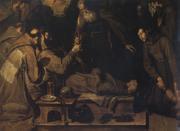 |
Bartolome Carducho -- Click Here
|
|
Italian, 1554-1608 |
|
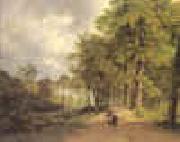 |
Barend Cornelis Koekkoek -- Click Here
|
|
1803-1862
Dutch
Barend Cornelis Koekkoek Gallery
Koekkoek??s own paintings reveal a careful study and synthesis of Dutch seventeenth century painters. His art is firmly rooted in the great Dutch romantic tradition established by the seventeenth-century masters: Hobbema, Cuyp, Ruisdael and Wynants. The golden light and the inclusion of travellers in his work suggests Koekkoek also admired the Dutch Italianate painters of the seventeenth century, collectively known as the Bamboccianti, especially Pieter van Laer and Jan Both.
Koekkoek imagined his pictures as the result of an ideal combination of observation and artifice. He studied art and nature with equal acuity, creating beautiful landscape paintings that celebrated the greatness of Creation. ??Koekkoek's work impresses the spectator by its power, by the firm and correct construction of the trees, by the broad, natural growth of the leaves and boughs, [and] by the careful and elaborate reproduction of the wooded landscape?? (G. H. Marius, Dutch Painters of the Nineteenth Century, Woodbridge, 1973, p. 89). Up to this day, Willem Koekkoek's work is very much favoured for the lively composition and the mood of nostalgia, in which the Dutch Golden Age seems to linger on. Just as he was during his own lifetime, Koekkoek is widely regarded as the most accomplished landscape painter of Dutch romanticism, against whose scrupulously refined paintings the work his contemporaries is measured.
|
|
|
|
|
|
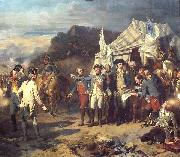 |
Auguste Couder -- Click Here
|
|
(1 April 1790 in Paris - 21 July 1873 in Paris) was a French painter and student of Jean-Baptiste Regnault and Jacques Louis David. He joined the Academie des beaux-arts in 1839 and was an officer of the Legion d'honneur. He married Cornelie Stouf, daughter of the sculptor Jean-Baptiste Stouf.
Couder was buried in the cemetery of Pere-Lachaise.
|
|
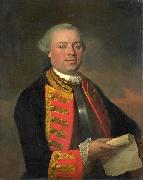 |
August Christian Hauck -- Click Here
|
|
(1742 -1801 ) - Painter |
|
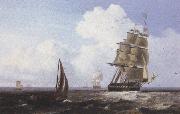 |
Attributed to john wilson carmichael -- Click Here
|
|
1800-1868
|
|
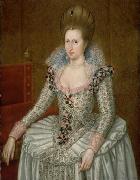 |
Attributed to John de Critz the Elder -- Click Here
|
|
painted Portrait of Anne of Denmark in c. 1605 |
|
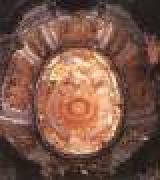 |
ASAM, Cosmas Damian -- Click Here
|
|
German Baroque Era Sculptor, 1686-1739
Bavarian architects and decorators. After studying in Rome (1711 ?C 13), Cosmas Damian became a prolific fresco painter, and his brother, Egid Quirin, became a sculptor and stuccoist. They developed the effects of dramatic lighting and illusionism originated by Gian Lorenzo Bernini and Andrea Pozzo. Working as a team, they produced magnificent illusionistic decoration in ecclesiastical buildings, combining dramatic lighting and colour. Their works are notable for their profound and dramatic intensity of religious feeling. The brothers became the principal late Baroque exponents of illusionist decoration in religious architecture. Their most notable collaboration is the church of St. John Nepomuk in Munich (1733 ?C 46) ?? known as the Asamkirche in honour of the brothers. |
|
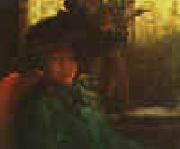 |
Artur Timoteo da Costa -- Click Here
|
|
Brazilian
1882-1923
Artur Timoteo da Costa Gallery
|
|
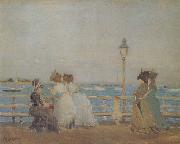 |
Arthur Clifton Goodwin -- Click Here
|
|
American Painter, ca.1864-1929 |
|
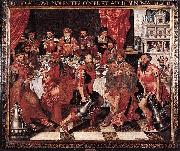 |
Antoon Claeissens -- Click Here
|
|
(his name is given in many varieties, with his first name rendered as Anton, Anthonie, Anthony, Anthuenis, and his surname as Claes, Claesz, Claeis, Claeiss, Claessens and Claeissins), the son of Pieter Claes the elder, painted historical and allegorical subjects, and portraits. He was a native of Bruges, and there entered the Guild of St. Luke in 1575, and became its dean in 1586, 1590, and 1601. He died in 1613. His works, several of which are in the Hôtel-de-Ville and churches of Bruges, are distinguished by their fine colouring and finish. In the H6tel-de-Ville is a 'Grand Banquet' with many portraits of magistrates of the time, dated 1574.
His son, Pieter Anthonie, was dean of the Guild of St. Luke at Bruges in 1607, and died in 1608.
|
|
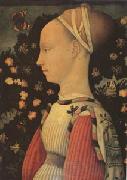 |
Antonio Puccio Called Pisanello -- Click Here
|
|
Verona before 1395-ca 1455 |
|
|
|
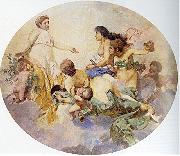 |
Antonio Cortina Farinos -- Click Here
|
|
February 16, 1841, Almassera, Valencia - November 6, 1890) was a Spanish artist. |
|
 |
Antonio Ciseri -- Click Here
|
|
(October 25, 1821 ?C March 8, 1891) was a Swiss painter of religious subjects.
Ciseri was born in Ronco sopra Ascona in the canton of Ticino in Switzerland. In 1833 he moved with his father to Florence. He was admitted in 1834 to the Accademia di Belle Arti, where he trained under Niccola Benvenuti. In 1849, he began offering instruction to young painters, and eventually ran a private art school. Among his earliest students was Silvestro Lega.[1]
Ciseri's religious paintings are Raphaelesque in their compositional outlines and their polished surfaces, but are nearly photographic in effect. He fulfilled many important commissions from churches in Italy and Switzerland. Ciseri also painted a significant number of portraits. He died in Florence on March 8, 1891.
|
|
|
|
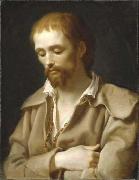 |
Antonio Cavallucci -- Click Here
|
|
(21 August 1752 - 18 November 1795) was an Italian painter of the late Baroque.
Cavallucci was born in Sermoneta in the Lazio. His artistic talents were recognized in an early stage by Francesco Caetani, Duke of Sermoneta in 1738-1810. In 1765, he brought the 13 year old Cavallucci to Rome, where he became a pupil of Stefano Pozzi and three years later of Gaetano Lapis. He also studied drawing at the Accademia di San Luca (c. 1769-1771).
His earliest work dates from the mid-1760s. It is a tempera frieze in the Casa Cavallucci in Sermoneta. His first portrait was of his benefactor Duke Francesco Caetani. This portrait is only preserved as an engraving in 1772 by Pietro Leone Bombelli (1737-1809).
His first major commission was the decoration of five audience chambers in the Caetani Palace in Rome in 1776. He painted mythological scenes and allegories appropriate for each room.
In the early 1780s he painted mostly portraits, such as those of Francesco Caetani and Teresa Corsini, Duchess of Sermoneta.
The Origin of Music (1786) is probably the most important painting of his mid-career. It was based on the illustrations in the book Iconologia (1593) from Cesare Ripa.
The commissions kept coming under his new patron, Cardinal Romualdo Braschi-Onesti (1753-1817), nephew of the pope Pius VI. He has painted the portraits of his new benefactor and of the pope in 1788.
He was inducted into the Accademia di San Luca in 1786, Academy of Arcadia in 1788, and the Congregazione dei Virtuosi al Pantheon in 1788.
He is said to have painted St Benedict Joseph Labre while the saint was in ecstasy, or (as is perhaps more plausible), having seen the saint in ecstasy, to have brought him to his studio and painted his portrait there. In later years he worked for Cardinal Francesco Saverio Zelada, decorating his titular church San Martino ai Monti in Rome. Cavallucci died in Rome in 1795.
He was influenced by Pompeo Batoni and Anton Raphael Mengs. There is in his art some of the northern European feeling that had made its way into Rome at the end of the eighteenth century. The Portuguese painter Domingos Sequeira was one of his pupils.
|
|
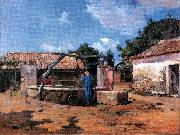 |
Antonio Carvalho de Silva Porto -- Click Here
|
|
(Porto, 11 November 1850 - Porto, 11 June 1893) was a Portuguese naturalist painter.
Born in Porto, he studied there under João Antenio Correia and T. Furtado, then continued his studies in Paris and Rome.
While in Paris he exhibited his work in the Salon and in the World´s Fair of 1878. In Paris, he studied with his friend João Marques de Oliveira, where they were pupils of Adolphe Yvon and Alexandre Cabanel. They became followers of the naturalist Barbizon School, and brought the new school of painting to Portugal, when they returned in 1879.
Silva Porto become one of the most acclaimed naturalist painters of his generation, showing the heritage of Jean-Baptiste Camille Corot and Charles-François Daubigny. Secondary effects from impressionism can sometimes be found in his paintings.
|
|
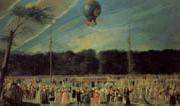 |
Antonio Carnicero -- Click Here
|
|
Spanish Rococo Era Painter, ca.1748-1814
was a Spanish painter of the Neoclassic style. Born in Salamanca and died in Madrid. He was trained with his father, Alejandro Carnicero, a sculptor. He then traveled to Rome and returned to be named chamber painter for King Charles III of Spain. He also worked as an engraveor. |
|
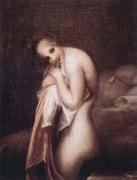 |
Antonio Canova -- Click Here
|
|
Italian Neoclassical Sculptor, 1757-1822
Italian sculptor, painter, draughtsman and architect. He was the most innovative and widely acclaimed sculptor of NEO-CLASSICISM. His development during the 1780s of a new style of revolutionary severity and idealistic purity led many of his contemporaries to prefer his ideal sculptures to such previously universally admired Antique statues as the Medici Venus and the Farnese Hercules, thus greatly increasing the prestige of 'modern' sculpture. He was also much in demand as a portrait sculptor. |
|
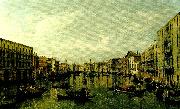 |
antonio canaletto -- Click Here
|
|
Giovanni Antonio Canal (28 October 1697 - 19 April 1768) better known as Canaletto, was a Venetian painter famous for his landscapes, or vedute, of Venice. He was also an important printmaker in etching. |
|
 |
Antonio Carnicero -- Click Here
|
|
1748-1814
Italian Antonio Carnicero Location
Antonio Carnicero (1748- 1814) was a Spanish painter of the Neoclassic style.
Born in Salamanca and died in Madrid. He was trained with his father, Alejandro Carnicero, a sculptor. He then traveled to Rome and returned to be named chamber painter for King Charles III. He also worked as an engraveor. He illustrated and edition of Don Quixote. |
|
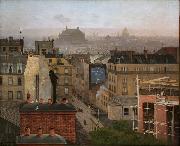 |
Antonin Chittussi -- Click Here
|
|
(1 December 1847 - 1 May 1891) was a Czech Impressionist landscape painter.
He was born in Ronov nad Doubravou to a Czech mother and a father of Italian descent. He was fascinated by the landscape of South Bohemia and of the Bohemian and Moravian Highlands. In particular, his smaller pictures replete with quick, easy brushstrokes are among the most admired of Czech landscape painting. He died in Prague.
|
|
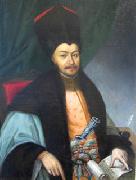 |
Anton Chladek -- Click Here
|
|
painted Portrait of Ienachita Vacarescu in 1794 - 1882 |
|
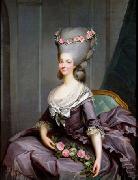 |
Antoine-Francois Callet -- Click Here
|
|
(1741-1823, Paris), generally known as Antoine Callet, was a French painter of portraits and allegorical works, who acted as official portraitist to Louis XVI.
He won the grand prix de Rome in 1764 with Cleobis et Biton conduisent le char de leur mere au temple de Junon (Kleobis and Biton dragging their mother's cart to the temple of Juno). He was accepted by the Academie des beaux arts in 1779, with his entry piece being a portrait of the comte d'Artois, and received with his allegory Le printemps (Spring) in 1781. He exhibited at the Salon from 1783 onwards. He painted the centre of the ceiling of the grande galerie of the palais du Luxembourg, with a composition entitled L'Aurore (Aurora). Under the French Consulate and the First French Empire he painted several more allegories, including an Allegorie du dix-huit brumaire ou la France sauvee (Allegory of 18 Brumaire, or France saved - 1801, château de Versailles) and an Allegorie de la bataille d'Austerlitz (Allegory of the Battle of Austerlitz - 1806, château de Versailles).
|
|
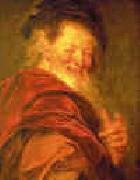 |
Antoine Coypel -- Click Here
|
|
1661-1722
French
Antoine Coypel Location
Antoine studied at the Coll?ge d Harcourt and then trained in his father studio and at the Academie Royale. In 1672 No Coypel was made Director of the Academie de France in Rome, and Antoine, who accompanied his father to Italy, benefited from the education given to the students there. He also joined in their long sessions spent copying Raphael frescoes in the Vatican Loggie and the works of the Carracci and Domenichino in the Palazzo Farnese. He met Giovanni Lorenzo Bernini and Carlo Maratti and was awarded a drawing prize by the Accademia di S Luca. During his return journey Antoine stopped in northern Italy to study the works of Correggio |
|
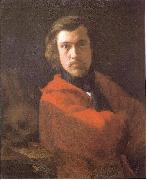 |
Antoine Chintreuil -- Click Here
|
|
Antoine Chintreuil
Antoine Chintreuil (May 15, 1814 - August 8, 1873) was a French landscape painter.
He was born in Pont-de-Vaux, Ain and grew up in Bresse. In 1838 he moved to Paris, where he began studying under Paul Delaroche in 1842. The following year he met Corot, who influenced him profoundly by encouraging him to paint landscape en plein air.
Art historian Athena S. E. Leoussi suggests that Chintreuil's work can be divided into three periods: From c. 1846-1850 he painted Paris and its surroundings, particularly Montmartre; from 1850-1857 he lived in Igny and frequently painted in Barbizon, and from 1857 on he lived and worked in La Tournelle-Septeuil in the Seine valley. During this final period his work reached its fullest development, and he achieved critical recognition.
In the breadth and simplicity of his execution, and in his attention to capturing light and atmosphere, Chintreuil can be placed alongside Eugene Boudin, Johan Barthold Jongkind, and the painters of the Barbizon school, as an important forerunner of Impressionism.
He died in Septeuil, Seine-et-Oise in 1873. |
|
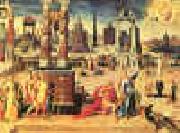 |
Antoine Caron -- Click Here
|
|
1520-1598
French
Antoine Caron Location
Antoine Caron (1521 in Beauvais - 1599 in Paris) was a French master glassmaker, illustrator, Mannerist painter and a master (teacher) at the School of Fontainebleau.
He is one of the few French painters of his time who had a pronounced artistic personality. His work reflects the refined, although highly unstable, atmosphere at the court of the House of Valois during the French Wars of Religion of 1560 to 1598. |
|
 |
Anthony Vandyck Copley Fielding -- Click Here
|
|
English
1787-1855 |
|
 |
ANTHONISZ Cornelis -- Click Here
|
|
b. ca. 1499, Amsterdam, d. ca. 1555, Amsterdam
Dutch printmaker, painter and cartographer, maternal grandson of JACOB CORNELISZ. VAN OOSTSANEN. He was the dominant figure in the creation of north Netherlandish woodcuts from the mid-1530s until his death. His monogram, which combines the initials 'C' and 'T' with the staff and bell of St Anthony, was probably inspired by his father's first name. The greater part of his career was apparently spent in his native Amsterdam, where he probably trained with his grandfather. |
|
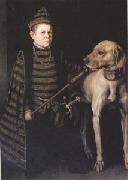 |
Anthonis Van Dashorst Called antonio Moro -- Click Here
|
|
Utrecht 1519-Antwerp 1575 |
|
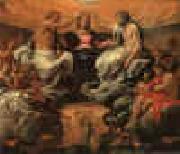 |
Annibale Carracci -- Click Here
|
|
1560-1609
Italian
Annibale Carracci Locations
Painter, draughtsman and printmaker, brother of (2) Agostino Carracci. Since his lifetime, he has been considered one of the greatest Italian painters of his age. His masterpiece, the ceiling (1597-1601) of the Galleria Farnese, Rome, merges a vibrant naturalism with the formal language of classicism in a grand and monumental style. Annibale was also instrumental in evolving the ideal, classical landscape and is generally credited with the invention of CARICATURE. |
|
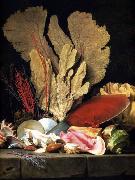 |
Anne Vallayer-Coster -- Click Here
|
|
French Rococo Era Painter, 1744-1818,was an eighteenth-century French painter. Known as a prodigy artist at a young age, she achieved fame and recognition very early in her career, being admitted to the Royal Academy in 1770, at the age of twenty-six.
Despite the negative reputation that still-life painting had at this time, Vallayer-Coster??s highly developed skills, especially in the depiction of flowers, soon generated a great deal of attention from collectors and other artists. Her precocious talent and the rave reviews?? earned her the attention of the court, where Marie Antoinette took a particular interest in Vallayer-Coster's paintings.
Regardless of her closeness to the ancient regime and France's hated monarch she survived the bloodshed of the French Revolution. However, the fall of the French monarchy, which were her primary patrons, caused her banishment into the shadows.
Anne Vallayer-Coster was a woman in a man??s world. It is unknown what she thought of contemporaries who admitted her to the confraternity, and made her an honorary ??man??. Her life was determinedly private, dignified and hard-working. Occasionally she attempted other genres, but for the usual reasons her success at figure painting was limited
|
|
|
|
|
|
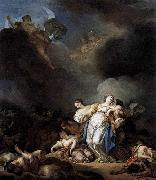 |
Anicet-Charles-Gabriel Lemonnier -- Click Here
|
|
French Painter, 1743-1824 |
|
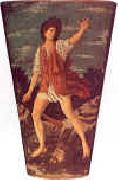 |
Andrea del Castagno -- Click Here
|
|
Italian
c1421-1457
Andrea del Castagno Location
Italian
c1421-1457
Andrea del Castagno Location
Italian painter. He was the most influential 15th-century Florentine master, after Masaccio, of the realistic rendering of the figure and the representation of the human body as a three-dimensional solid by means of contours. By translating into the terms of painting the statues of the Florentine sculptors Nanni di Banco and Donatello, Castagno set Florentine painting on a course dominated by line (the Florentine tradition of disegno), the effect of relief and the sculptural depiction of the figure that became its distinctive trait throughout the Italian Renaissance, a trend that culminated in the art of Michelangelo. |
|
 |
Andien de Clermont -- Click Here
|
|
Andien de Clermont (d.1783) was a French artist who worked in England in the 18th century (ca.1716-1756). He was particularly known for his decorative flower paintings in the Rococo style, and for "singeries, chinoiseries, and turqueries." He decorated interiors at Kirtlington Park, Langley Hall, Wentworth Castle, Wilton House, and "the second earl of Strafford's (now destroyed) dining room at No. 5 St. James's Square, London."
|
|
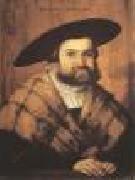 |
AMBERGER, Christoph -- Click Here
|
|
German Painter, ca.1500-1562
German painter and draughtsman. His family came from the Upper Palatinate. He served his apprenticeship in Augsburg, probably with Leonhard Beck, whose daughter Barbara he married. He became a master on 15 May 1530 but rarely signed his work. He was in northern Italy and Venice c. 1525-7. His full-length pendant portraits of a husband and wife (both 1525; Vienna, Ksthist. Mus.) show Venetian influence, and the portrait of Anton Welser (1527; priv. col., see 1980 exh. cat., p. 98) is in the Italian style. According to Sandrart, during the Imperial Diet of 1530 in Augsburg Amberger painted a portrait of Emperor Charles V to the Emperor's satisfaction, but the surviving work (Berlin, Gem?ldegal.) dates from 1532, based on the age given. In the decades that followed, Amberger was the favourite portrait painter of ambitious merchant families, such as the Fugger, who belonged to guilds but were connected with the nobility by family or marriage ties. |
|
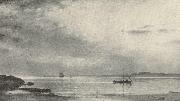 |
Amaldus Clarin Nielsen -- Click Here
|
|
(23 May 1838 - 10 December 1932) was a Norwegian painter.
He was born in Halse as a son of shipmaster and merchant Niels Clemetsen Nielsen (1795 - 1845) and his wife Andrea Marie Møller (1802 - 1866). He grew up in Mandal in Vest-Agder county, Norway. He lived most of his childhood and adolescence without a father. He received some tuition from a traveling drawing teacher and traveled to Copenhagen to study in 1854
|
|
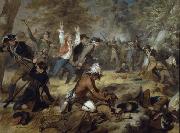 |
Alonzo Chappel -- Click Here
|
|
Alonzo Chappel (1828 - 1887) was an American painter, best known for paintings depicting personalities and events from the American Revolution and early 19th-century American history.
Chappel was born in New York City and died in Middle Island, New York. |
|
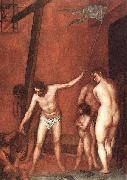 |
Alonzo Cano -- Click Here
|
|
Alonzo Cano or Alonso Cano (19 March 1601 - 3 September 1667) was a Spanish painter, architect and sculptor born in Granada. He learned architecture from his father, Miguel Cano;painting in the academy of Juan del Castillo, and from Francisco Pacheco the teacher of Velezquez; and sculpture from Juan Martenez Montañes. As a sculptor, his most famous works are the Madonna and Child in the church of Lebrija (also called Nebrija), and the colossal figures of San Pedro and San Pablo.
He was made first royal architect, painter to Philip IV, and instructor to the prince, Balthasar Charles, Prince of Asturias. The King gave him the church preferment of a canonof the Granada Cathedral (1652), in order to take up a position as chief architect of the cathedral, where his main achievement in architecture was the façade, designed at the end of his life and erected to his design after his death.[citation needed]
Ideal portrait of a Spanish King.He was notorious for his ungovernable temper; and it is said that once he risked his life by committing the then capital offence of dashing to pieces the statue of a saint, when in a rage with the purchaser who begrudged the price he demanded.[1] According to another story, he found his house robbed after coming home one evening, his wife murdered, and his Italian servant fled. Notwithstanding the presumption against the fugitive, the magistrates condemned Cano, because he was of a jealous temper. Upon this he fled to Valencia, but afterwards returned to Madrid, where he was put to the torture, which he endured without incriminating himself, and the king received him into favour.
After the death of his wife he took Holy Orders as a protection from farther prosecution, but still continued his professional pursuits. He died in 1676. In his last moments, when the priest held to him a crucifix, he told him to take it away; according to the Catholic Encyclopedia, this was because the priest gave the Sacrament to conversos. |
|
 |
Alonso Sanchez Coello -- Click Here
|
|
Alonso Sachez Coello (1531/32 -August 8, 1588) was a portrait painter of the Spanish Renaissance and one of the pioneers of the great tradition of Spanish portrait painting.
Alonso Sachez Coello was born in Benifairode les Valls, near Valencia, and spent his childhood there, until the death of his father when he was around ten years old. He was educated in Portugal at his grandfather's home. Coello's years in Portugal and his family name of Portuguese origin led to a long-standing belief that he was in fact Portuguese. His grandfather (after whom he was named) was in the service of King John III of Portugal who sent the young painter to study with Anthonis Mor (also known as Antonio Moro) in Flanders around 1550. He was under the service of Antoine de Granville, bishop of Arras, learning from Mor. While studying in Flanders, Coello also spent time copying some of Titian's works. |
|
|
|
|
| | |
|
|
|
|